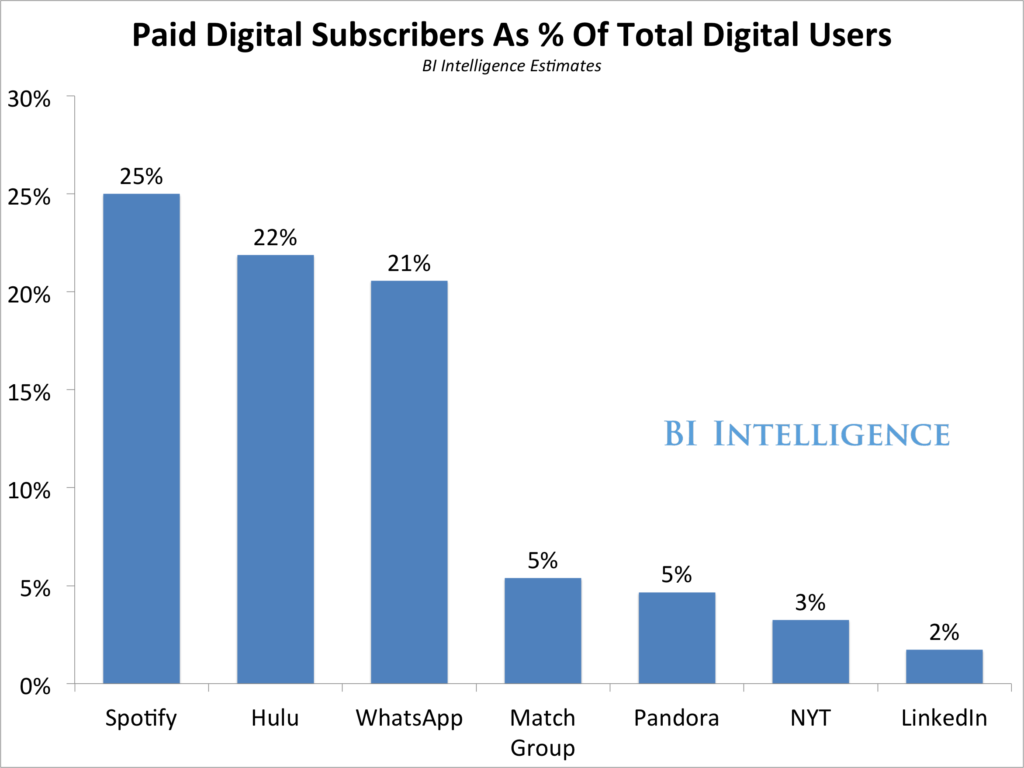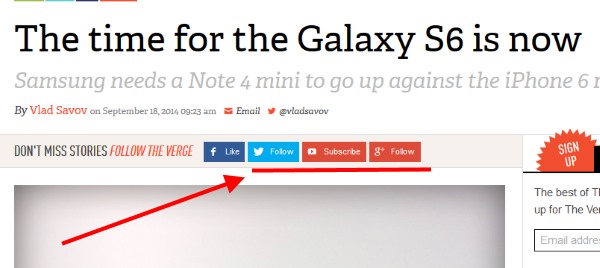What are visitors who use Adblock worth?
There’s a debate raging among online publishers whether or not visitors who use Adblock to block ads with should be blocked from accessing their websites.
On one side of the debate are major publishers like Forbes, Washington Post and German mega-publisher Axel Springer, who have blocked ad-blockers by varying degrees with large ‘Not Welcome’ screens that ask readers to disable their ad-blocker in exchange for website access — or in exchange for an “ad reduced” or “ad light” experience.

On the other side of the debate are a chorus of pundits who present a laundry-list of reasons for why publishers should welcome all readers — whether or not those readers block ads.
One of the more persistent reasons given for why publishers should allow Adblock readers to continue to access their content is that an ad-blocking readers still have some value other than the obvious monetizable value of advertising views, clicks or taps.
Is there value outside of ad views?
Web publishers have long had alternative revenue models other than traditional ‘banner’ advertising. Those models include affiliate relationships, paid subscriptions, native advertising, direct product sales, sales of readership data, paid access to archival articles and many others. But despite the broad range of potential ways to monetize content, traditional advertising is still by far the largest source of revenue for the majority of traditional online publishers. Streaming services and apps whose ads can be more difficult to block have fared better than traditional online publishers in transitioning to paid-content models. While traditional-media giants like the New York Times have long struggled to build premium online subscribership in an ocean of non-premium competitors.

Other media giants like Bloomberg, The Wall Street Journal along with smaller sites featuring “required reading” industry-news have been able to transition to subscription models better than most.
Unfortunately, these latter examples are the exception not the rule. For most online publishers, advertising still rules the day. And without advertising revenue, the majority of publishers could not survive.
What about social media?
A common argument made against blocking ad-blockers is that each and every user, with or without Adblock, represents the potential for social sharing and promotion on Facebook, Twitter, LinkedIn and other networks. This potential for broad engagement and viral growth has led many publishers to grudgingly accept ad-blocking readers despite the knowledge that there will be zero chance of traditional monetization. Hypothetically, if an ad-blocking visitor were to share an article on Facebook, and that article were to be read by an additional 10 people –the lost potential of the original reader’s ad views would be compensated by the increased potential of those ten new visitors.
Or so the argument goes.

Social sharing potential doesn’t compensate for ad-blocking.
There are two problems with the “social sharing” argument against blocking ad-blockers:
First, this argument assumes that the recipients of social-shares don’t block ads themselves. To be fair, this argument was at one time more valid than it is now: When ad-blocking was a fringe practice, employed by a small percentage of Internet users, the likelihood that one’s social followers also blocked ads was slim. But as ad-blocking has become an increasingly mainstream practice — and as ad blocking becomes a built-in feature for more and more web-browsers –the pool of non-adblocking readers is shrinking daily. The likelihood that social media followers also block ads is now uncomfortably high for many publishing sectors.
On the positive side, it must be said that the value of social shares will always be non-zero because somewhere in the viral-growth chain there will likely be readers who do not block ads. Unfortunately however, there is a wide margin between that non-zero per-user value and the necessary minimum value to maintain commercial viability. The net benefit of social shares may still be negative on a per user basis for Adblock users.
Ad-blockers block social sharing buttons too
Which brings us to the second problem with the “social sharing” argument: Social sharing itself is increasingly endangered by ad-blocking. Many ad-blockers now block social sharing buttons along with ads. By blocking social sharing buttons ad-blocking software negates even the increasingly limited potential-upside of online virality.
Users of Adblock Plus will recognize these settings from their Options panel:

That Facebook “Like” button doesn’t just “track your browsing habits” as Adblock Plus’ authors put it. It’s also one of the last reasons to not block Adblock. What exactly is the value of a user who consumes content, can’t click ads and can’t share on social media?
[ On a side note, it’s a little hard to stomach complaints about “tracking” made visitors who use Facebook in the first place. The company capitalizes on personal data gleaned from the use of the site, and from one’s network of friends. The hypocrisy of privacy advocates who complain about privacy issues while continuing to support companies who make a living out of selling personal data is something to be saved for another post. ]
What about native advertising?
Frequently heralded as a solution to the problem of ad-blocking, native advertising (or advertising which mimics non-advertising content) is also a victim of ad-blocking. While publishers originally billed native advertising as “invisible” the user, the FTC recently ruled that native ads must be identifiable as such. The problem of course, is that any native-ad which is identifiable by a user as “advertising”, is also identifiable by ad-blockers as such.
So what’s the value of an Adblock user to a website?
What many Adblock users don’t consider is the cost of maintaining a publication or service per user. Traditional media publications with hundreds of journalists, editors, photographers and other employees are typically more costly on a per-user basis than pure-play new-media companies. But even new-media giants like Facebook face daunting per-user costs: The MIT technology review reported that Facebook spends approximately $1 per month, per user.
Facebook spent $860 million, or about $1 per active monthly user, to deliver and distribute its products last year. The bulk of that money was related to data center equipment, staff, and operating costs.
[Those numbers were even higher in 2015]
Facebook says a whopping 85% of their revenue comes from advertising. When millions of users each install Adblock and thereby “convert” from recurring revenue generators, to being nothing more than a recurring monthly cost, one must ask at which point the tipping point will be reached? Online publications, like their offline cousins require considerable overhead to keep moving. For the vast majority of the world’s websites, advertising is what makes the wheels keep turning.
It’s important to note that in many cases the value of an Adblock user to an online publication may not just be zero — it may be less than zero when accounting for server costs and administrative overhead. Does an Adblock user who costs Facebook $1 per month, generate $1 per month without generating ad revenue? Probably not.
Even without ad-blocking, many publications survive on razor thin margins. In highly competitive spaces like gaming, ad-blocking rates have soared above 50%. If we haven’t yet reached the point of negative returns, our current vector suggests that point is not far off.
This math has not been lost on large publishers like Forbes, City AM, GQ and others who report successful recapture of lost revenue after blocking adblock. One should not assume they have mistakenly discounted the benefits of social sharing, native advertising or alternative revenue streams.
Somewhere along the line it has seemingly been forgotten by a generation of web users that content costs money. There’s a reason all of this amazing web content is magically free. Removing the bits we don’t like, doesn’t make it “free and better”. It makes it not free, or not around at all.

This is what happen when block-ad-block is successful.
Social sharing is often hopelessly overrated anyway. And when every other user is blocking ads, it doesn’t matter how many people social share.
You’re still multiplying by zero.
Block Adblock!
I don’t hate Ads, but unfortunately ads come with something I absolutely loathe — localization. I travel around a lot and so it becomes more and more annoying getting crap from “around me”…
So yeah, until ad companies give you the option of selecting where you want to see ads from, f*** ’em and f*** all you anti-adblocker folks.
And what about the user’s point of view? Yes, I get that the internet isn’t free. I didn’t mind ads, initially. I didn’t mind when it was a simple picture, relevant to the content on the page. I started to take issue when ads became obtrusive – when they started taking up the page, popping up at random moments, slowing down my internet speed, playing sounds and TRACKING ME. That’s something I’m not okay with. I’m not comfortable with being profiled and analyzed by ad companies for profit. It’s a violation of privacy, and as someone weary of control its a segue to far too much of it.
If ads are honest, I’m okay with them. But when they intrude, I’ll block them. Every time.
As they say the customer is always right, if there is a site that offends you because, of ads stop visiting, I mean there are a million and one other sites, as a publisher it was my choice to place the ad, if you didn’t like it don’t come back. The only choice you should have is to not visit the site not to unilaterally decide your ready to have one part and not the other.
so lets say a website like the washington post uses ads that pop up and redirect you everytime you click. People wouldn’t go to that site and they would lose money. I disable adblock for sites that have legit non clickbait and noninrusive ads.
One dollar a month for content? Why not?
We need to get stronger filters, more destructive ways of blockiing ad block blockers even to the point of DDoS. THEN when we start moving to a pay to view model, the internet will cut the scum and become much better than ever before.
Content creation costs money, blocking ads just because you feel they are obtrusive is tantamount to throwing out the baby with the bath water, mind you not all site have such ads. Ultimately ad blocking will come at a price which is low quality to no content at all, which also mean increase in job losses and it’s attendant consequences. I don’t see any good coming from ad blocking, personally , I feel publishers have a case against ad block. I mean if a created a an article for instance and placed an ad with intention that anyone who takes the time read my article should see the ad, and then a third party empowers a reader to, all intents and purposes alter my content, should be wrong seeing how I dilibrately put the ad there, the ad should be regarded as part of my content and should be treated as such. If a website is putting up ads you don’t like, stop going to that site, it should be as simple as that.
“What are websites that force ads to visitors worth?” nothing, because i enter once and then block from my search results forever. Content is not exclusive of a single page.